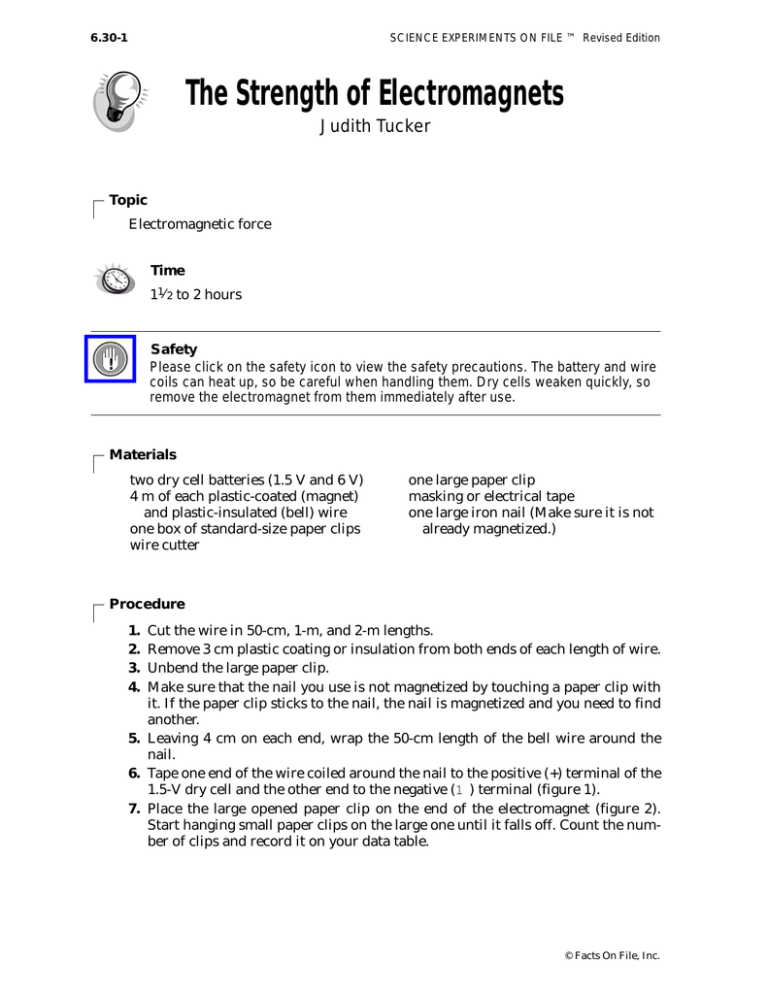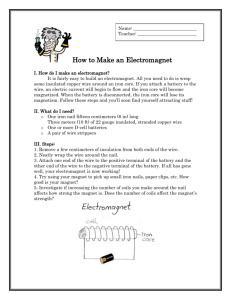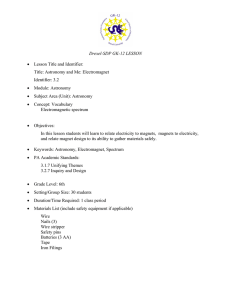The Strength of Electromagnets
advertisement

6.30-1 SCIENCE EXPERIMENTS ON FILE ™ Revised Edition The Strength of Electromagnets Judith Tucker Topic Electromagnetic force Time 11⁄ 2 to 2 hours Safety Please click on the safety icon to view the safety precautions. The battery and wire coils can heat up, so be careful when handling them. Dry cells weaken quickly, so remove the electromagnet from them immediately after use. ! Materials two dry cell batteries (1.5 V and 6 V) 4 m of each plastic-coated (magnet) and plastic-insulated (bell) wire one box of standard-size paper clips wire cutter one large paper clip masking or electrical tape one large iron nail (Make sure it is not already magnetized.) Procedure 1. 2. 3. 4. Cut the wire in 50-cm, 1-m, and 2-m lengths. Remove 3 cm plastic coating or insulation from both ends of each length of wire. Unbend the large paper clip. Make sure that the nail you use is not magnetized by touching a paper clip with it. If the paper clip sticks to the nail, the nail is magnetized and you need to find another. 5. Leaving 4 cm on each end, wrap the 50-cm length of the bell wire around the nail. 6. Tape one end of the wire coiled around the nail to the positive (+) terminal of the 1.5-V dry cell and the other end to the negative (1 ) terminal (figure 1). 7. Place the large opened paper clip on the end of the electromagnet (figure 2). Start hanging small paper clips on the large one until it falls off. Count the number of clips and record it on your data table. © Facts On File, Inc. SCIENCE EXPERIMENTS ON FILE™ Revised Edition 6.30-2 Figure 1 1.5-V battery tape iron nail wire Figure 2 opened paper clip D ATA T A B L E Length and type of wire Number of paper clips held by electromagnet 1.5-V dry-cell battery 6-V dry-cell battery 50 cm (magnet) 50 cm (bell) 1 m (magnet) 1 m (bell) 2 m (magnet) 2 m (bell) 8. Remove the electromagnet from the dry cell, and slip the wire coil off the nail. Repeat steps 5 through 7, using the 1-m and 2-m lengths of bell wire. Record all your results on the data table. 9. Repeat steps 5 through 7 with the three lengths of magnet wire. Record all your results on the data table. 10. Repeat steps 5 through 7 with the 50-cm lengths of both types of wire, using the 6-V dry cell instead of the 1.5-V cell. Record all your results on the data table. © Facts On File, Inc. 6.30-3 SCIENCE EXPERIMENTS ON FILE™ Revised Edition 11. What effect did each of the following factors have on the strength of the electromagnet? Why do you think each of the following variables affects the strength of the electromagnet in the way in which it does? a. different lengths of wire b. different gauges (thicknesses) of wire c. different voltages of the dry cells 12. How do electromagnets differ from other magnets? What’s Going On For each type of wire, the greater length makes for a stronger magnet. A longer wire allows you to wrap more coils around your core (the nail). Each loop acts like a separate magnet, so as you increase the number of magnets, you increase the strength of the whole electromagnet. The thickness of the wire has a similar effect: The thinner gauge allows you to wrap more loops close together around the nail; adding loops is like adding more magnets. Therefore, the 50-cm length of thin-coated wire makes a magnet that is much stronger even than the one made from the 2-m length of the thicker bell wire, because it has more loops. The electromagnets using the 6-V dry cell are stronger. The larger voltage adds current to the electromagnet, increasing the strength, because there are more electrons (current) moving through the wire, increasing the magnetic field. Electromagnets differ from other magnets because they are temporary: When you turn off the current, you turn off the magnet. Another way in which they differ is that you can make an electromagnet stronger or weaker by increasing the number of loops or the amount of current you are using. Connections Over 2,000 years ago, it was discovered that when a substance called lodestone was brought near a piece of iron, the iron was attracted to it. We now know that this phenomenon is the result of the property called magnetism. Some substances exhibit magnetism and others do not. Magnetic substances are attracted by magnets and can be magnetized (made into magnets themselves). One way to make a temporary magnet is to pass an electric current through a wire wrapped around a core made of a magnetic substance, such as an iron nail. This is called an electromagnet. In this experiment, you found out how to make an electromagnet and what makes one stronger or weaker. © Facts On File, Inc. Safety Precautions READ AND COPY BEFORE STARTING ANY EXPERIMENT Experimental science can be dangerous. Events can happen very quickly while you are performing an experiment. Things can spill, break, even catch fire. Basic safety procedures help prevent serious accidents. Be sure to follow additional safety precautions and adult supervision requirements for each experiment. If you are working in a lab or in the field, do not work alone. This book assumes that you will read the safety precautions that follow, as well as those at the start of each experiment you perform, and that you will remember them. These precautions will not always be repeated in the instructions for the procedures. It is up to you to use good judgment and pay attention when performing potentially dangerous procedures. Just because the book does not always say “be careful with hot liquids” or “don’t cut yourself with the knife” does not mean that you should be careless when simmering water or stripping an electrical wire. It does mean that when you see a special note to be careful, it is extremely important that you pay attention to it. If you ever have a question about whether a procedure or material is dangerous, stop to find out for sure that it is safe before continuing the experiment. To avoid accidents, always pay close attention to your work, take your time, and practice the general safety procedures listed below. PREPARE • Clear all surfaces before beginning work. • Read through the whole experiment before you start. • Identify hazardous procedures and anticipate dangers. PROTECT YOURSELF • Follow all directions step by step; do only one procedure at a time. • Locate exits, fire blanket and extinguisher, master gas and electricity shut-offs, eyewash, and first-aid kit. • Make sure that there is adequate ventilation. • Do not horseplay. • Wear an apron and goggles. • Do not wear contact lenses, open shoes, and loose clothing; do not wear your hair loose. • Keep floor and work space neat, clean, and dry. • Clean up spills immediately. • Never eat, drink, or smoke in the laboratory or near the work space. • Do not taste any substances tested unless expressly permitted to do so by a science teacher in charge. USE EQUIPMENT WITH CARE • Set up apparatus far from the edge of the desk. • Use knives and other sharp or pointed instruments with caution; always cut away from yourself and others. • Pull plugs, not cords, when inserting and removing electrical plugs. • Don’t use your mouth to pipette; use a suction bulb. • Clean glassware before and after use. • Check glassware for scratches, cracks, and sharp edges. • Clean up broken glassware immediately. v © Facts On File, Inc. vi Safety SCIENCE EXPERIMENTS ON FILE™ REVISED EDITION • Do not use reflected sunlight to illuminate your microscope. • Do not touch metal conductors. • Use only low-voltage and low-current materials. • Be careful when using stepstools, chairs, and ladders. USING CHEMICALS • Never taste or inhale chemicals. • Label all bottles and apparatus containing chemicals. • Read all labels carefully. • Avoid chemical contact with skin and eyes (wear goggles, apron, and gloves). • Do not touch chemical solutions. • Wash hands before and after using solutions. • Wipe up spills thoroughly. HEATING INSTRUCTIONS • Use goggles, apron, and gloves when boiling liquids. • Keep your face away from test tubes and beakers. • Never leave heating apparatus unattended. • Use safety tongs and heat-resistant mittens. • Turn off hot plates, bunsen burners, and gas when you are done. • Keep flammable substances away from heat. • Have a fire extinguisher on hand. WORKING WITH MICROORGANISMS • Assume that all microorganisms are infectious; handle them with care. • Sterilize all equipment being used to handle microorganisms. GOING ON FIELD TRIPS • Do not go on a field trip by yourself. • Tell a responsible adult where you are going, and maintain that route. • Know the area and its potential hazards, such as poisonous plants, deep water, and rapids. • Dress for terrain and weather conditions (prepare for exposure to sun as well as to cold). • Bring along a first-aid kit. • Do not drink water or eat plants found in the wild. • Use the buddy system; do not experiment outdoors alone. FINISHING UP • Thoroughly clean your work area and glassware. • Be careful not to return chemicals or contaminated reagents to the wrong containers. • Don’t dispose of materials in the sink unless instructed to do so. • Wash your hands thoroughly. • Clean up all residue, and containerize it for proper disposal. • Dispose of all chemicals according to local, state, and federal laws. BE SAFETY-CONSCIOUS AT ALL TIMES © Facts On File, Inc.




